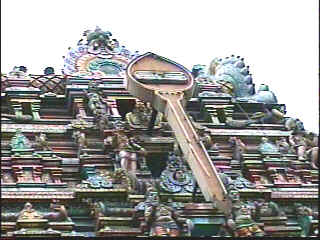Skanda is enshrined as a renunciate
(Dhandayutapani) as in Palani, or with his consorts Valli
and Deivayanai in most shrines, with Deivayanai alone in
Tirupparankunram, with Valli
alone in Velimalai. He is enshrined either in a seated or in a standing posture - either
in the six faced Shanmukha form or in the single faced Subramanya
form.

The peacock is considered to be
Skanda's favourite mount. Skanda is always seen armed with a spear - the Vel.
The very symbol Vel is held in high regard in Tamilnadu and is symbolic
of victory (Vetri Vel). The six faces of Skanda (Shanmukhan)
represent the union of the five faced Shiva
with Parvati.
Most temples enshrining the Skanda follow the Saiva
Agamas in worship protocols. The Skanda shrines in the southern district of
Kanyakumari and some temples in vicinity of Tirunelveli such as Tiruchendur follow the Keralite Kumara
Tantram form of worship.
Most of the shrines to Skanda are highly endowed and
have a rich tradition of grand festivals. The sixth phase of the moon in the bright half
of each month Sashti- as well as the Kartikai asterism
each month is an occasion for special worship.
Other days sacred to Skanda throughout the year are Thai
Poosam, Panguni Uttiram, Vaikasi Vishakam, Aadi Kartikai, Thai Kaartikai, Kartikai Deepam
and Skanda Sashti. Most of these special occasions are marked by devotees
carrying Kaavadis in procession, in a manner reliving the legend of Idumban at Palani.
For details on over 50 Murugan temples in Tamilnadu,
Karnataka and Kerala visit Abodes of Skanda.
